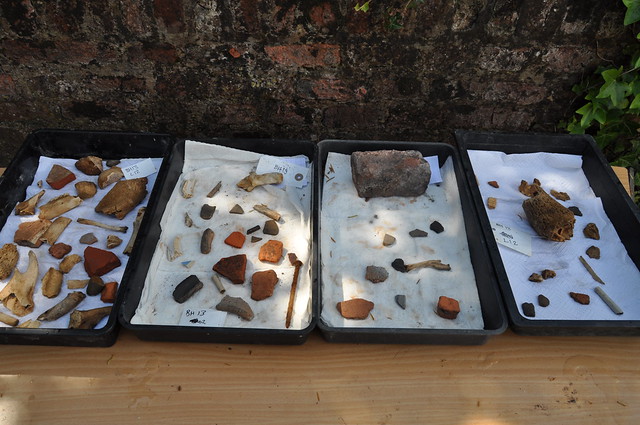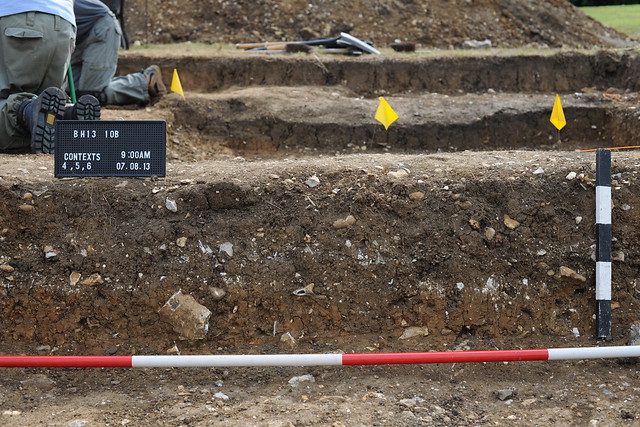Day 17 – A View from the Trench Edge – by Sophie, Jamie and Sam
On the penultimate day of the excavation Sophie took a few minutes out with a number of members of the excavation team to ask them about their views on the project and if it had met the aims set out at the start.
Dave (Co-Director)
“The dig has been very successful, in that we have not only uncovered the original 60’s excavation, but have been able to add information to the existing record. Some questions we set out to answer have been difficult to as we discovered that the ‘roundhouses’ had been over-dug, however what we’ve shown with sections and the opening up of areas by removing the baulk is a better understanding of the site as a whole. The original box-grid method used in the 60’s has proven to be very confined on a site like this- it has been much easier to interpret an area once it has been opened up.”
Nicole (Co-Director)
“I think the dig has gone really well. We started out with a few different aims; to allow the students of Southampton to experience a variety of different aspects of archaeological fieldwork, and to confirm the 1960’s report of the area, as there is not a huge archive of information concerning the original excavation. It took us quite a while to define the original edges of the 1960’s excavation, but despite this slight set-back it has been really interesting to experience the ‘archaeology of archaeology’.
The finding of old survey pegs from the original excavation and replica pottery left behind by re-enactors has allowed us to add to the story of the site. More recently the finding of Roman coins within baulks has nicely high-lighted the extensive history of occupation at the site.
One noticeable aspect of the dig has been the interest from local people and the amount of volunteers. It just demonstrates that people from all different backgrounds, with mixed experience can contribute to archaeology- there is something that everybody can get involved with.”
Gareth (Co-Director)
“The main aim of the dig was to further refine the findings of the 60’s excavation and to build a more rounded idea of the site as a whole through the different layers of occupation. I think we have been successful in doing this. The digitisation aspect of the dig has been useful in documenting the corbels mounted in the old museum, so that there is now a three-dimensional record of them. The RTI (Reflectance Transformation Imaging) has also allowed us to create images within which objects can be interactively relit in different ways, which has been particularly useful in reading the Roman coins found on site.”
Dan (Excavation Supervisor)
“I feel that we have been successful in achieving our aims, the main aim being to demonstrate what was dug in the 60’s. I think we were also successful in demonstrating that a lot of what they found in the 60’s has since been destroyed, possibly due to over-digging or the lack of back-filling.”
Lizzie (Survey Supervisor)
“I think we have definitely achieved our aims over the past three weeks and everyone has learnt something different.”
Jude (Finds Supervisor)
“I think we have found roughly what we expected to find in the last three weeks. It is quite noticeable that we’re getting much higher quality finds from the baulks that have been excavated over the last few days of the dig, especially in the case of the Roman coins, which if identifiable will give us an idea of the date of Roman occupation on the site. From a finds point of view there is not much of a gap between the Roman and Iron Age pot as they are coming from similar contexts, and this indicates that the site was most likely continuously occupied.
The roman finds are not particularly high status and this suggests to me that there may have been a set of farmers living in the area who had adopted Roman culture, but were not able to afford really sophisticated items. However, now that the baulks are coming down, we are beginning to find more Samian ware and fineware which suggests that perhaps the Roman occupants were able to afford more elite equipment. Generally speaking it looks as though the material is more prolific in the early Roman period, especially in terms of the fineware.”

Finds drying in the sunshine after gentle cleaning by the Finds Team.

The moment another Roman coin is found.
Ellie (Bones Expert)
“From the bones found so far, I have been able to pick out mostly sheep and cow remains, however there is also a pig tooth. These finds suggest that there were domesticated animals on the site, hinting at a farming community as sheep and cow are the most commonly found remains on domestic sites. However this is not conclusive as there have only been small fragments of bone recovered and there is quite bad preservation.”

Bones discovery.
Chris (Co-Director)
“I’m really pleased with how well the dig has gone, it was a bit of an experiment in the sense that it was not just about excavation, but other elements of archaeology like geo-phys, engaging with the public and digital and creative aspects. We also had the opportunity to visit Hampton court which was interesting and very relevant as it allowed us to visualise how Basing House may have once looked.
The dig itself was also interesting due to the complexity of the site. We have had the opportunity to dig a variety of different archaeology due to the many different periods of occupation ranging all the way from the Iron age/Roman to the Civil War. It has also been good to have a dig with people from all different backgrounds, including students with a variety of experience, volunteers and staff.
From a public perspective I think the presence of the dig has added a special dimension to the site as it has created excitement, not only for the viewing public, but for the staff. The education aspect of the dig has been very important in engaging the public as there is often a real barrier between archaeology and the public. The open-days we have offered have allowed students to engage with the public and create activities to try and appeal to the local community and gain interest.”

Part of Ellie and Richard’s bones display.
Alice (University of Southampton, 1st Yr)
“The best part of the dig was learning how to recognise finds and analysing them to create a bigger picture of the overall site.”
Vicky (University of Southampton, 1st Yr)
“The dig has been a good learning experience. I am particularly interested in Magnetometry and digitisation and it was great to be able to put that into practice, as well as being involved in fieldwork.”
Alina (University of Southampton, 2nd Yr)
“It has been really good to be involved with a wide variety of archaeological activities on this dig, as there is something for everyone. The ‘archaeology of archaeology’ was a new concept for me as I have never dug anything like it. Overall I think it has been a well-rounded experience.”
Miriam (Basingstoke Volunteer)
“This has been a really good experience. It has been a lot harder than expected, but it has given me a realistic idea of what field archaeology is about, especially as I am going to be starting an archaeology course at the University of Southampton in September. One thing I really did notice is how welcoming everyone is. I found it really easy to integrate my self into the group and feel like I have built up some really good relationships with the staff and student community for next year.
I have never done any finds work before and have found the post-analysis really interesting, especially thinking about an objects background and use. The message that has really come across from this dig is how important field-archaeology is to archaeology as a whole.”
Olivia (Chineham Volunteer)
“I live in Chineham, a few miles away from site, and have always been interested in archaeology, partly because there is so much history in the area. As a child I always thought it would be really interesting to find something and this dig has given me the opportunity to do that. It has been quite tough in the trench sometimes but there has been a good atmosphere and I have definitely learnt a lot. The best part of the dig by far, has been meeting people who share my interest.”
Neil (Basingstoke Volunteer)
“The dig at Basing House has been a new type of dig for me as I have dug mostly on Roman sites. It has been very interesting, even from day one, particularly because of the different layers of occupation. It has been interesting finding cuts in the stratigraphy and the small finds have been really interesting.”

A section set up for photographing.
Filed under: Archaeology of Archaeology, Chris Elmer, Dan Joyce, Dave Allen, Day Seventeen, Gareth Beale, Jude Jones, Lizzie Richley, Meet the Team, Nicole Beale, Student Reporter, Summer Excavation
